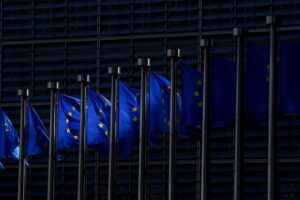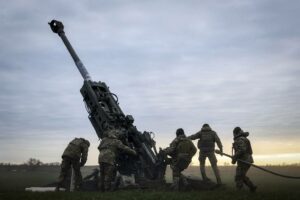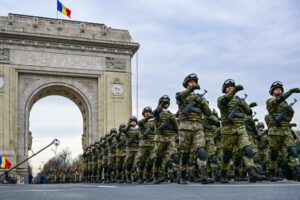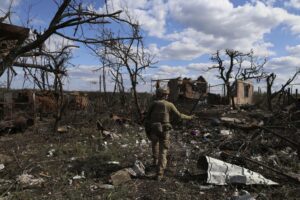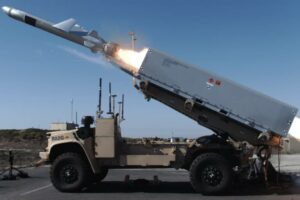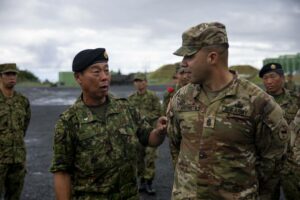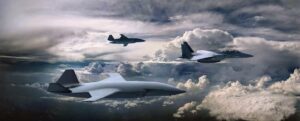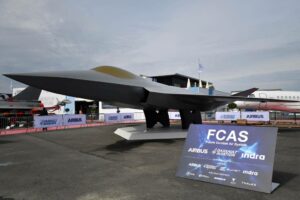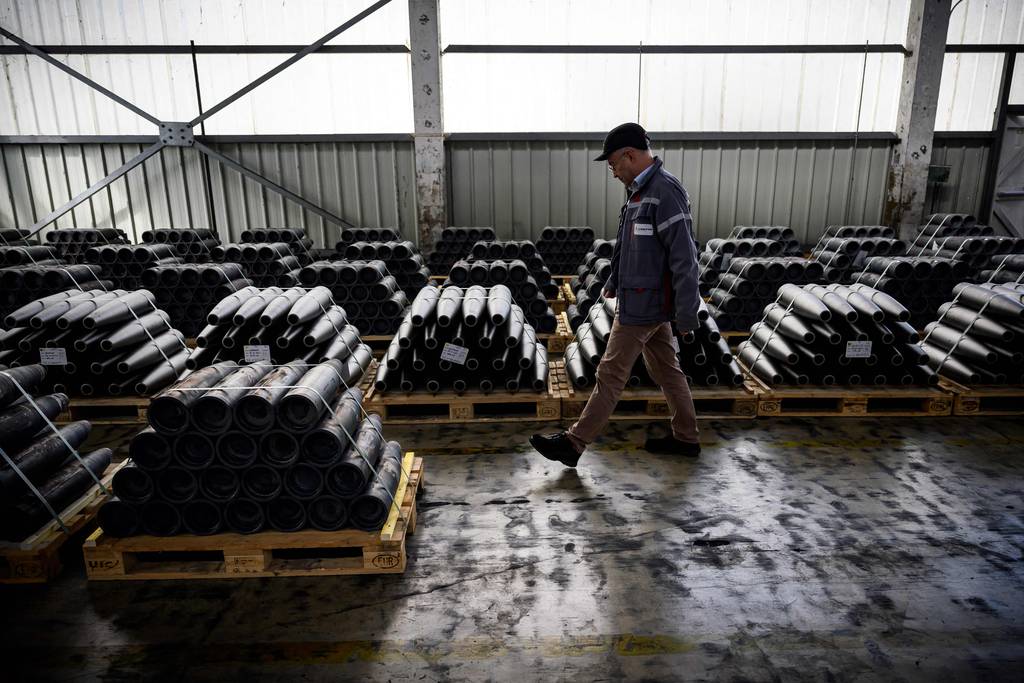
ROME — As the European Union figures out how to spend €1 billion on bullets and shells for Ukraine, the buildup of a massive weapons cash pile it will use is sparking debate about the bloc’s new-found appetite for arms purchases.
Better known for trade deals and farming subsidies, the EU now boasts a war chest of €8 billion, known as the European Peace Facility, which it is using to arm Russia’s neighbors, compensating EU states which donate tanks, planes and guns to Kyiv – and now buying ammunition for Ukraine.
The questions are however coming fast, starting with a key conundrum: Should the money be lavished on manufacturers in the EU states supplying the money, or used anywhere that ensures quick purchases, even if that means U.S. manufacturers?
Speedy buying has been central to the promise made by the bloc in March to provide one million items of ammunition to Ukraine within 12 months as the country’s fighters run short ahead of an expected counter-offensive against invading Russian forces.
To achieve that, the EU Council earmarked €1 billion from the Peace Facility to partially compensate EU members donating their stocks to Ukraine and another €1 billion for joint procurement of new ammunition.
But while France has said it would prefer to see the €1 billion procurement made in Europe, Poland has pushed for no limits on where the cash is spent, said Jean-Pierre Maulny, the deputy director at French think tank IRIS and scientific coordinator of its ARES defense research group.
“France believes there is no problem obtaining this amount of ammunition from European suppliers, but Poland does not agree,” he said, adding that material could be supplied by Finland, France, Germany and the Czech Republic.
One reason for the discussion is that the EU is still writing the rules as it gets used to becoming an arms buyer.
Set up in March 2021, the Peace Facility was given a €5 billion budget and funded armed forces in countries like North Macedonia, Moldova, Nigeria, Jordan and Georgia.
Following Russia’s February 2022 invasion of Ukraine, the budget was beefed up as the fund focused on aiding Kyiv, and now stands at just under €8 billion for the period 2021-2027.
Compensation to EU states which donate defense materials to Ukraine are now underway, with Slovakia, for example, saying it hopes to receive about €200 million from the fund after handing over kit including 13 out-of-commission Mikoyan MiG-29 fighter jets.
“The EPF’s prime objective is to strengthen Europe’s defense capacities, so of course it would be best if the funds were used to develop European defense manufacturing capabilities,” said Tomasz Smura, the head of the research office of the Warsaw-based think tank Casimir Pulaski Foundation
“Naturally, the EU’s largest countries, who are also major weapon producers, are taking steps to ensure that the reimbursements are primarily used to reinforce the European defense industry,” he said.
Reimbursement payments have come under scrutiny recently after a Politico report in March suggested that Estonia had applied a value calculation of donated equipment that unduly taxed collective coffers, billing the EPF for the cost of comparable new kit.
The Estonian government denied any wrongdoing, saying it had acted in accordance with reimbursement policies.
And in the case of Slovakia’s warplanes transaction, Defense Minister Jaroslav Nad announced having received a U.S. offer for 12 Bell AH-1Z attack helicopters at $340 million that an Associated Press article described as “compensation” for the Ukraine donation.
On Nov. 15 last year, the EU issued a rule that compensation cash handed out did not have to be spent in the bloc – it could also be used to buy most products in the United States.
Detailing the decision, an EU spokesperson told Defense News, “EU member states have agreed on a series of rules, particularly when the items are on the Common Military List of the European Union, which limit their origin to EU, member states and a number of non-EU countries, including the U.S.”
Those other non-EU countries include Norway, Canada, Israel, South Korea, the U.K. and others, the spokesperson added.
The EU’s Common Military List, which is a long list of defense products governed by EU export rules, includes guns, howitzers, cannons, mortars, anti-tank weapons, rifles, rockets, missiles, bombs, ships, aircraft, drones, tanks and armored vehicles.
It also includes ammunition. However, in March, when the European Union Council issued recommendations for speeding up the joint ammunition purchase for Ukraine using Peace Facility funds, it stated: “The Council further calls on member states to jointly procure 155-mm ammunition and, if requested, missiles for Ukraine in the fastest way possible before 30 September 2023 from the European defense industry (and Norway).”
Explaining why the recommendation excluded U.S. purchases despite the Peace Facility rules allowing such buys, an EU source, speaking on condition of anonymity to discuss sensitive deliberations, told Defense News the rules had been conceived to help armed forces around the world which benefited from the fund and might have needed to buy from outside the EU.
The huge amounts of money involved in the ammunition buy, meanwhile, meant the cash was better off being spent in the EU, the source argued.
“It is however a recommendation and is now being discussed,” he said.
The EU spokesperson added, “The EPF is an instrument in the hands of the member states. They decide how the EPF is used.” The spokesperson described ongoing discussions as confidential.
“I can see why member states would be uncomfortable about putting money in a pot which subsidizes U.S. industry, but reality bites if your own industry cannot meet the requirement fast enough,” said Daniel Fiott, an analyst at the Centre for Security, Diplomacy and Strategy (CSDS) of the Brussels School of Governance.
Jaroslaw Adamowski in Warsaw contributed this this report.
Tom Kington is the Italy correspondent for Defense News.
- SEO Powered Content & PR Distribution. Get Amplified Today.
- PlatoAiStream. Web3 Data Intelligence. Knowledge Amplified. Access Here.
- Minting the Future w Adryenn Ashley. Access Here.
- Source: https://www.defensenews.com/global/europe/2023/04/28/eu-nations-quarrel-over-where-to-buy-fresh-ammo-for-ukraine/
- :has
- :is
- :not
- :where
- $UP
- 12
- 12 months
- 13
- 2021
- 2022
- 2023
- 30
- 70
- a
- About
- accordance
- Achieve
- added
- adding
- After
- against
- ahead
- aircraft
- Allowing
- also
- ammunition
- amount
- amounts
- an
- analyst
- and
- announced
- Anonymity
- Another
- any
- anywhere
- appetite
- applied
- ARE
- ARM
- armed
- arms
- around
- article
- AS
- associated
- At
- attack
- BE
- becoming
- been
- before
- being
- believes
- Bell
- BEST
- Better
- billing
- Billion
- boasts
- Brussels
- budget
- but
- buy
- Buying
- Buys
- by
- Calls
- CAN
- Canada
- cannot
- capabilities
- capacities
- case
- Cash
- central
- centre
- Collective
- come
- coming
- Common
- comparable
- Compensation
- conceived
- condition
- contributed
- Coordinator
- Cost
- could
- Council
- countries
- country’s
- course
- Czech
- czech republic
- Daniel
- Deals
- debate
- decide
- decision
- Defense
- deputy
- described
- Despite
- develop
- DID
- Diplomacy
- Director
- discuss
- discussed
- discussion
- discussions
- does
- donate
- donating
- donation
- Drones
- enough
- ensure
- ensures
- equipment
- estonia
- EU
- Europe
- European
- european union
- Europes
- Even
- example
- excluded
- expected
- export
- Facility
- farming
- FAST
- fastest
- February
- fighters
- Figures
- Finland
- focused
- For
- Forces
- France
- French
- fresh
- from
- fund
- funded
- funds
- further
- Georgia
- Germany
- given
- governance
- Government
- Group
- GUNS
- had
- Hands
- Have
- having
- he
- head
- help
- hopes
- How
- How To
- However
- HTTPS
- huge
- if
- images
- in
- include
- includes
- Including
- industry
- instrument
- invasion
- involved
- Israel
- Issued
- IT
- Italy
- items
- ITS
- Jets
- joint
- Jordan
- jpg
- just
- Key
- kit
- known
- korea
- largest
- Last
- Last Year
- like
- LIMIT
- limits
- List
- Long
- made
- major
- Manufacturers
- manufacturing
- March
- massive
- material
- materials
- means
- Meanwhile
- Meet
- member
- Members
- might
- Military
- million
- missiles
- money
- months
- most
- Nations
- needed
- neighbors
- New
- news
- Nigeria
- no
- North
- Norway
- now
- number
- objective
- obtaining
- of
- off
- offer
- Office
- on
- ONE
- ongoing
- or
- Origin
- Other
- Others
- out
- outside
- over
- own
- particularly
- payments
- peace
- period
- Planes
- plato
- Plato Data Intelligence
- PlatoData
- Poland
- policies
- possible
- pot
- prefer
- press
- primarily
- Prime
- Problem
- Producers
- Products
- promise
- provide
- purchase
- purchases
- pushed
- Putting
- Questions
- Quick
- Reality
- reason
- receive
- received
- recently
- Recommendation
- recommendations
- reinforce
- report
- Republic
- requested
- requirement
- research
- research group
- Rule
- rules
- Run
- russian
- s
- Said
- saying
- School
- security
- see
- sensitive
- September
- Series
- ships
- Short
- should
- So
- Source
- South
- South Korea
- speaking
- spend
- spent
- spokesperson
- stands
- Starting
- stated
- States
- Steps
- Still
- Stocks
- Strategy
- Strengthen
- such
- supplied
- suppliers
- supplying
- taking
- tank
- Tanks
- that
- The
- the joint
- The Source
- the world
- their
- There.
- they
- think
- think tank
- this
- to
- trade
- transaction
- U.K.
- u.s.
- Ukraine
- under
- Underway
- union
- United
- United States
- use
- used
- using
- value
- Vehicles
- war
- Warplanes
- Warsaw
- was
- Way..
- Weapons
- were
- when
- which
- while
- WHO
- why
- will
- with
- within
- world
- would
- writing
- year
- Your
- zephyrnet

